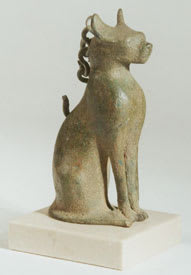Bronze Sculpture of a Cat, 650 BCE - 30 CE
Bronze
4.4 x 14 cm
1 3/4 x 5 1/2 in
1 3/4 x 5 1/2 in
FZ.386
The ancient Egyptians were conservative and traditional with regard to their design for depictions of cats. Most of the known representations in both two and three dimensions rely on a...
The ancient Egyptians were conservative and traditional with regard to their design for depictions of cats. Most of the known representations in both two and three dimensions rely on a seated attitude, as here, in which the beloved feline sits on its hind legs with its erect fore legs drawn up close to the chest in order to create a compact body from which the head with its perked up ears emerges, attentive and focused. In these compositions, the tail of the cat is invariably wrapped around the proper right-hand side of the animal closely following the contour so that its tip ends at or about even with the claws of the right paw.
Our example is unusual in that it still exhibits an original suspension loop on its back into which links of the original chain are likewise well preserved. Other examples of bronze cats are known which are provided with suspension loops and it was not uncommon for the ancient Egyptians to attach similar loops to other bronze statuettes, such as images of Osiris, which are, to a modern critic, of such a large size that they would have seemed cumbersome, if worn as pendants suspended from necklaces and the like.
Because the pose of our cat is one that was so long-lived, it is difficult to determine with precision its exact chronological position. Nevertheless, there is general agreement that such cats gained in popularity during the course of the Late Period and continued to be created into the Ptolemaic Period. Consequently, one can suggest a dating for our cat in the period between about 650 and 30 BC.
References:
For cats in general, see J. Malek, The Cat in Ancient Egypt (London 1993), and particularly page 102, figure 66, and page 110, figure 86, for bronze depictions of cats which incorporate suspension loops into their design; see, also, G. Roeder, Ägyptische Bronzefiguren (Berlin 1956), plate 24, figure C, for a bronze Osiris provided with both a tang for insertion, presumably, into a base, as well as with a suspension loop.
Our example is unusual in that it still exhibits an original suspension loop on its back into which links of the original chain are likewise well preserved. Other examples of bronze cats are known which are provided with suspension loops and it was not uncommon for the ancient Egyptians to attach similar loops to other bronze statuettes, such as images of Osiris, which are, to a modern critic, of such a large size that they would have seemed cumbersome, if worn as pendants suspended from necklaces and the like.
Because the pose of our cat is one that was so long-lived, it is difficult to determine with precision its exact chronological position. Nevertheless, there is general agreement that such cats gained in popularity during the course of the Late Period and continued to be created into the Ptolemaic Period. Consequently, one can suggest a dating for our cat in the period between about 650 and 30 BC.
References:
For cats in general, see J. Malek, The Cat in Ancient Egypt (London 1993), and particularly page 102, figure 66, and page 110, figure 86, for bronze depictions of cats which incorporate suspension loops into their design; see, also, G. Roeder, Ägyptische Bronzefiguren (Berlin 1956), plate 24, figure C, for a bronze Osiris provided with both a tang for insertion, presumably, into a base, as well as with a suspension loop.
Literature
V30
